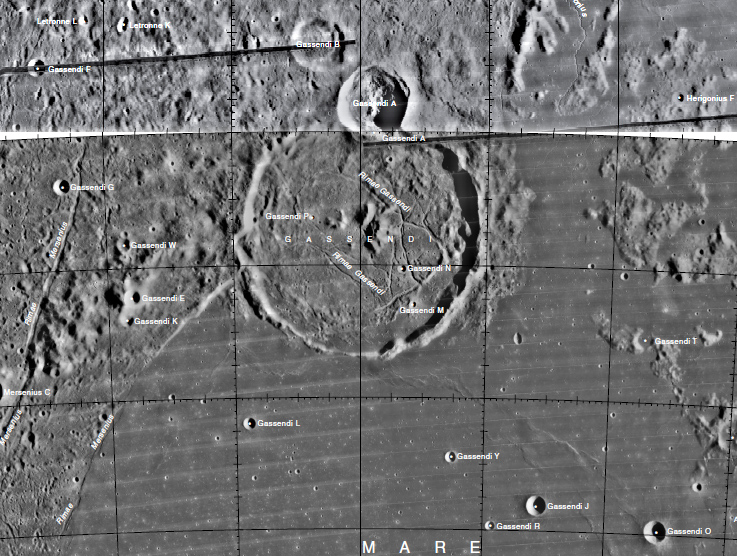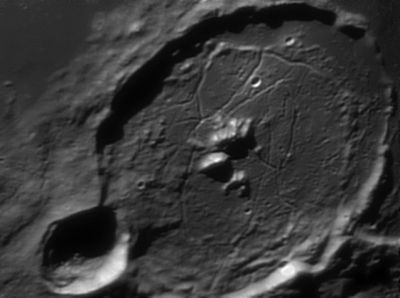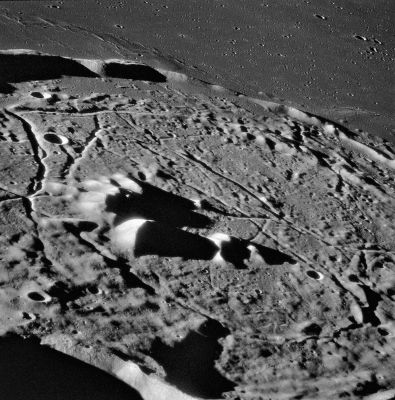Gassendi
Gassendi - and Clarkson (Gassendi A)
|
Lat: 17.5°S, Long: 39.98°W, Diam: 109.58 km, Depth: 1.42 km, Rükl: 52 | |
On Mike Wirths's telescopic photograph at left, both Gassendi and Clarkson (Gassendi A) were captured in fine detail. Clarkson was a discontinued name from H.P.Wilkins and P.Moore (see their book The Moon). Although discontinued, the name Clarkson is still printed on the recent version of the Hallwag moonmap, among other discontinued names from Wilkins and Moore.
Images
LPOD Photo Gallery Lunar Orbiter Images Apollo Images Wes Higgins image
- Close-ups of Gassendi, made by Lunar Orbiter 5, are seen here (Frames 5177, 5178, 5179). Research: Danny Caes.
Maps
(LAC zone 93A2) LAC map Geologic map
Description
Elger
(IAU Directions) GASSENDI.--One of the most beautiful telescopic objects on the moon's visible surface, and structurally one of the most interesting and suggestive. It is a walled-plain, 55 miles in diameter, of a distinctly polygonal type, the N.E. and S.E. sections being practically straight, while the intermediate E. section exhibits a slightly convex curvature, or bulging in towards the interior. There is also much angularity about the W. side, which is evident at an early stage of sunrise. The wall on the N. is broken through and almost completely wrecked by the great ring- plain Gassendi A. The bright western section of the border is in places very lofty, rising at one peak, N. of the well-known triangular depression upon it, to 9,000 feet, and at other peaks on the same side still higher. It is very low on the S., being only about 500 feet above the surface. The floor, however, on the N. stands 2,000 feet above the Mare Humorum. On the E. there is a peak towering 4,000 feet above the wall, which is here about 5,000 feet above the floor, and 8,000 feet above the Mare Nubium. A very notable feature in connection with this formation is the little bright plain bounding it on the N.E., and separated from it by merely a narrow strip of wall. This enclosure is flanked on the N.W. by Gassendi A, and on the S.E. and N.E. by a coarse winding ridge, running from the E. wall and terminating at a large irregular dusky depression. Gaudibert has detected a crater near the S.W. edge of this bright plain, which includes also some oval mounds. The interior of Gassendi is without question unrivalled for the variety of its details, and, after Plato, has perhaps received more attention from observers than any other object. The bright central mountain, or rather mountains, for it consists of a number of grouped masses crowned by peaks, of which the loftiest is about 4,000 feet, is one of the finest on the moon. It was carefully studied with a 6 1/4 inch Cooke-achromatic by the late Professor Phillips, the geologist, who compared it to the dolomitic or trachytic mountains of the earth. The buttresses and spurs which it throws out give its base a digitated outline, easily seen under suitable illumination. There are between 30 and 40 clefts in the interior, the majority being confined to the S.E. quarter of the floor. Those most easily seen pertain to the group which radiates from the central mountain towards the S.E. wall. They are all more or less difficult objects, requiring exceptionally favourable weather and high powers. A fine mountain range, the Percy Mountains, is connected with the W. flank of Gassendi, extending in a S.W. direction towards Mersenius, and defining the N.W. side of the Mare Humorum.
Wikipedia
Additional Information
- IAU page: Gassendi
- Depth data from Kurt Fisher database
- Pike, 1976: 1.42 km
- Westfall, 2000: 1.42 km
- Cherrington, 1969: 2.01 km
- Boint measured the depth at 1480m +or- 50m. Boint, 2001. - fatastronomer
- Boint measured the height of the central peak Gassendi Beta (long. 39.361W, lat. 15.545S) as between 900m-940m. Boint, 2001.- fatastronomer
- Measurements of crater topography using Kaguya laser altimeter terrain profile graphs. - LunarJim Feb 23, 2012
- Crater Depth: Measurements on 4 axes separated by 45 degrees.
- Zero reference level = Moon average radius.
- Average floor level (average of lowest levels on each of 4 axes) = -2.46km
- Average rim height (average of 8 rim data points) = -0.85km
- Average crater depth (average rim height to average floor level) = 1.62km
- Deepest point on crater floor (from zero reference level ) = -2.61km
- Max. crater depth (highest point on rim to deepest point on crater floor) = 2.66km
- Central Peak Height (above average floor level) = 1.37km
- Central peak composition: GNTA1 (Tompkins & Pieters, 1999)
- Crater with the 5th largest number of transient lunar phenoma reports: 16; A.P.S. Crotts (2007).
- Satellite crater Gassendi L is on the ALPO list of bright ray craters
- Gassendi A mapped as Copernican by USGS.
- Gassendi A: TSI = 25, CPI = 25, FI = 20; MI =70 Smith and Sanchez, 1973
- LROC view of impact material in Gassendi A.
Gassendi's illuminated central peak (sunrise terminator phenomenon)
Gassendi was the most eye-catching formation during the evening of august the 13th, 2016, around 9:00 U.T. (Waxing Gibbous Moon).
Its dark floor, its illuminated central peak, and also the crackled appearance of the partially illuminated western section of its rim were worthwile to observe! At the same moment, the two major peaks of the Montes Harbinger were also illuminated (two bright dots beyond the terminator, see drawing of the Montes Harbinger in Harold Hill's book A Portfolio of Lunar Drawings).
- DannyCaes Aug 13, 2016
Nomenclature
- Pierre Gassendi (January 22, 1592 – October 24, 1655) was a French philosopher, scientist, astronomer/astrologer, and mathematician, best known for attempting to reconcile Epicurean atomism with Christianity and for publishing the first official observations of the Transit of Mercury in 1631. Gassendi also participated, with Nicolas Peiresc, in supervising the production of some of the finest early maps of the Moon.
- This crater (Riccioli's Gassendi, or Gassendus) was called Annulus Neptuni by Langrenus (Neptune's Little Ring ?). The Gassendi of Langrenus was the crater which is nowadays officially known as Timocharis. Source: E.A.Whitaker's Mapping and Naming the Moon.
- Gassendi A, the 33 km wide crater cutting Gassendi's north rim, was named Clarkson by Wilkins and Moore, but the IAU did not accept the name. See also Roland L. T. Clarkson, Trimley's Moon Man (OASI) (Roland Lebeg Townley Clarkson, 1889-1954).
- The system of hills and hillocks east of Gassendi (between Gassendi and The Helmet) is known as the Andreus hills. This unofficial name (Andreus hills) was printed on the greenish Rand McNally Moon map and on a small version of the same moonmap in Patrick Moore's Atlas of the Universe (1983). The exact origin of the name Andreus hills is unknown. The dedicated lunar observer and photographer Bob Pilz calls these hills the Gassendi Archipelago.
- Another system of hills and hillocks (between Gassendi and Rimae Herigonius) is known as The Lobster and/or The Trilobite because of its peculiar lobster-like shape (as it shows through telescope). Source: Akkana Peck. A wonderful orbital close-up Hasselblad photograph of Akkana Peck's Lobster or Trilobite is Apollo 16's AS16-119-19178. Another one is Apollo 16's panoramic ITEK-frame AS16-P-5474 (the Lobster is noticeable near the frame's left margin). Research Apollo 16 photography: Danny Caes
- Michelin Man (or Bibendum) is the nickname of a cluster (or system) of hillocks east of Gassendi. This cluster is part of the southern section of the Andreus Hills.
Lunar 100
Lettered craters

Mosaic of LAC 75 and LAC 93. Excerpt from the USGS Digital Atlas of the Moon.
LROC Articles
LPOD Articles
- Unbelievable Image
- A Handy Guide to Gassendi
- Gassendi Compared
- Inside Gassendi
- Gasping at Gassendi
- Making Rilles Visible.
- Rotating Gassendi
- A Warhorse, Again
- Gassendi
- Upside Down Twins
- Full Moon Secrets
- Silly Big Image, Silly Diverse Rilles (Michael Wirths's Hi-Res photograph of Gassendi made with a new camera).
Bibliography
- Apollo Over the Moon, Chapter 5: Craters (Part 6), Figure 181.
- Hill, Harold. 1991. A Portfolio of Lunar Drawings., pages XVII and XIX (how to draw a lunar formation).
- Wood, C.A. Feb. 2000. The Glories of Gassendi. S&T Feb 2000 v99 p118
- Wood, C.A. Dec. 2004. Floor-Fractured Craters. S&T 12/2004:71
- Color events on the Moon, Patrick Moore (the Gassendi case of April 30/ May 1, 1966); Sky and Telescope, 33:27, 1967 (see also William R. Corliss, Mysterious Universe, a handbook of astronomical anomalies, pages 230/ 232).
Named Featues -- Prev: Rima Gärtner -- Next: Rimae Gassendi

